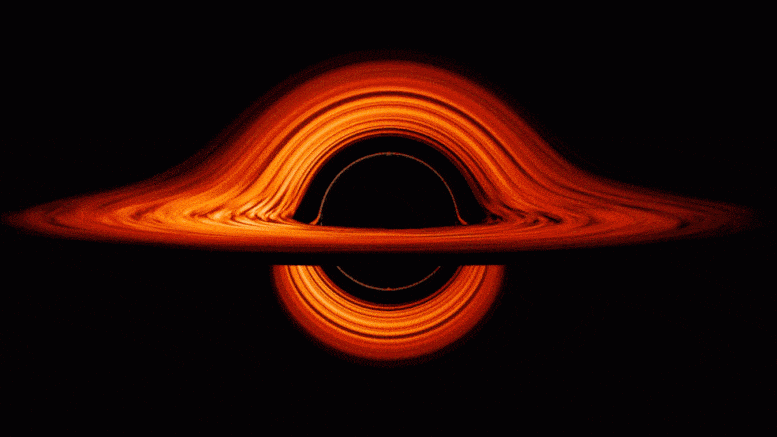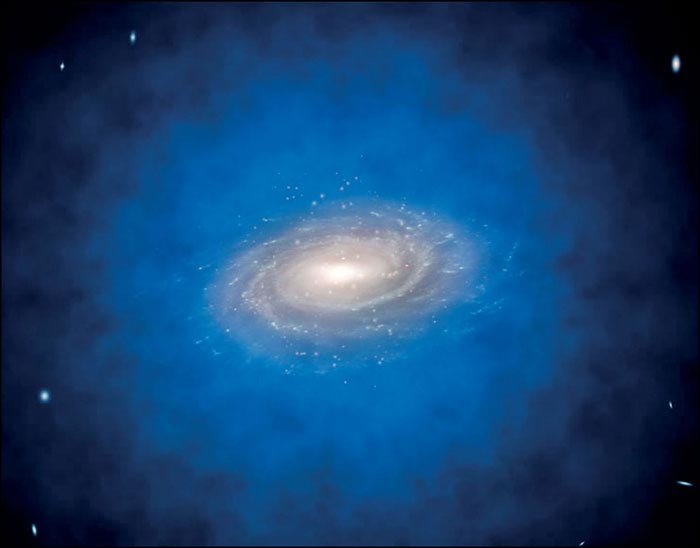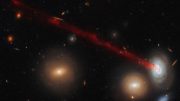
Turbulent disk of gas churning around a black hole. Credit: NASA’s Goddard Space Flight Center/Jeremy Schnittman
A new theoretical study has proposed a novel mechanism for the creation of supermassive black holes from dark matter. The international team find that rather than the conventional formation scenarios involving ‘normal’ matter, supermassive black holes could instead form directly from dark matter in high density regions in the centers of galaxies. The result has key implications for cosmology in the early Universe, and is published in Monthly Notices of the Royal Astronomical Society.
Exactly how supermassive black holes initially formed is one of the biggest problems in the study of galaxy evolution today. Supermassive black holes have been observed as early as 800 million years after the Big Bang, and how they could grow so quickly remains unexplained.
Standard formation models involve normal baryonic matter – the atoms and elements that make up stars, planets, and all visible objects – collapsing under gravity to form black holes, which then grow over time. However, the new work investigates the potential existence of stable galactic cores made of dark matter, and surrounded by a diluted dark matter halo, finding that the centers of these structures could become so concentrated that they could also collapse into supermassive black holes once a critical threshold is reached.

Artist’s impression of a spiral galaxy embedded in a larger distribution of invisible dark matter, known as a dark matter halo (colored in blue). Studies looking at the formation of dark matter haloes have suggested that each halo could harbor a very dense nucleus of dark matter, which may potentially mimic the effects of a central black hole, or eventually collapse to form one. Credit: ESO / L. Calçada
According to the model, this could have happened much more quickly than other proposed formation mechanisms, and would have allowed supermassive black holes in the early Universe to form before the galaxies they inhabit, contrary to current understanding.
Carlos R. Argüelles, the researcher at Universidad Nacional de La Plata and ICRANet who led the investigation comments: “This new formation scenario may offer a natural explanation for how supermassive black holes formed in the early Universe, without requiring prior star formation or needing to invoke seed black holes with unrealistic accretion rates.”
Another intriguing consequence of the new model is that the critical mass for collapse into a black hole might not be reached for smaller dark matter halos, for example, those surrounding some dwarf galaxies. The authors suggest that this then might leave smaller dwarf galaxies with a central dark matter nucleus rather than the expected black hole. Such a dark matter core could still mimic the gravitational signatures of a conventional central black hole, whilst the dark matter outer halo could also explain the observed galaxy rotation curves.
“This model shows how dark matter haloes could harbor dense concentrations at their centers, which may play a crucial role in helping to understand the formation of supermassive black holes,” added Carlos.
“Here we’ve proven for the first time that such core–halo dark matter distributions can indeed form in a cosmological framework, and remain stable for the lifetime of the Universe.”
The authors hope that further studies will shed more light on supermassive black hole formation in the very earliest days of our Universe, as well as investigate whether the centers of non-active galaxies, including our own Milky Way, may play host to these dense dark matter cores.
Reference: “On the formation and stability of fermionic dark matter haloes in a cosmological framework” by Carlos R Argüelles, Manuel I Díaz, Andreas Krut and Rafael Yunis, 31 December 2020, Monthly Notices of the Royal Astronomical Society.
DOI: 10.1093/mnras/staa3986









No they form from really big stars I think people sometimes forget how big the universe is. And if it was here first then your brain won’t let you imagine a star that big that’s all.
Think stars as big as galaxies try that then you imagine them everywhere in the early times . The bigger the star the more ?it’s made of. As we know the universe seems to be constantly breaking down over time. So try and imagine when the universe was so full of gases and cold. Let’s start there and then count down.
Hardly galaxy mass:
“Population III stars[20] are a hypothetical population of extremely massive, luminous and hot stars with virtually no metals, except possibly for intermixing ejecta from other nearby Population III supernovae. Such stars are likely to have existed in the very early universe (i.e., at high redshift), and may have started the production of chemical elements heavier than hydrogen that are needed for the later formation of planets and life as we know it.[21][22]”
“Current theory is divided on whether the first stars were very massive or not. One possibility is that these stars were much larger than current stars: several hundred solar masses, and possibly up to 1000 solar masses.”
[“Stellar population”, Wikipedia]
I also think it was cold as to much heat won’t let the gas collapse into stars would just be gas. And then you don’t need gravity.
You see I think that’s how it all started in the beginning the universe was cold and full of gases in snow form and as the snow gas collected it gave itself mass where as it wouldn’t if it was hot. And once these gas balls got to an enormous size the cores would start to warm up and melt.and as more snow collected on the surface of these balls the core would get hotter until the pressure at the core was so great that fusion started and the process hasn’t stopped since that’s what I like as a theory.
Note that the paper is theoretical and treats an alternative to current cosmology with cold dark matter (CDM) namely self interacting (here fermionic) “warm dark matter” (WDM):
“… we have performed a thermodynamic stability analysis in the microcanonical ensemble for solutions with a given particle number N, at the moment of halo virialization in a WDM cosmology, …”.
A competing paper found that dark matter is analogously *not* part of neutron star formation, supporting purely gravitationally interacting dark matter [ https://www.sciencealert.com/tiny-black-holes-could-form-inside-neutron-stars-and-devour-them-from-within ].
I think dark matter is the fabric of space in and of itself that’s why you can’t see it space is dark just like the matter is made of